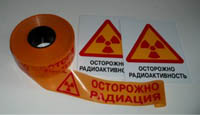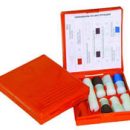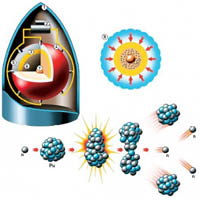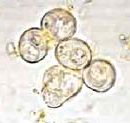Chronic radiation disease develops against the background of long-term small doses of ionizing irradiation. Depending on the absorbed dose and its own body sensitivity, the disease can flow in three versions.
Content
The concept of chronic radiation disease
Chronic radiation disease - a total long-term current disease that develops as a result of a long multiple exposure to ionizing radiation. The impact of radiation is carried out in relatively small (one-time) doses, noticeably exceeding the maximum allowable. Chronic radiation disease may occur both under military conditions and in conditions of professional exposure with rough violation of safety regulations.
Options for the flow of chronic radiation disease
The main symptoms and the flow of chronic radiation disease depend on the total dose of irradiation, the nature of the distribution of the absorbed dose, as well as from the individual radio sensitivity of the body.
In this regard, it is currently proposed to allocate three versions of chronic radiation disease in accordance with the conditions of radiation impact on the body. The first is the main variant of the disease - characterized by an external relatively uniform long-term exposure to radiation. The second option includes cases of chronic radiation disease from external and internal irradiation, characterized by the electoral local impact of radiation on organs and tissues. The third option of chronic radiation sickness covers combined forms characterized by various combination of the total and local radiation impact. The most complete deployed symptomatology of the disease is observed at the first primary version.
Chronic radiation disease is characterized by a gradual slow development, a long resistant flow and slow restoration of disturbed functions. Diseases to share for three periods:
- Period of formation of the disease
- Recovery period
- period of remote complications and consequences
For the conditions of chronic irradiation, there is no fairly accurate relationship between the resulting total dose of irradiation and the severity of the course of the disease. With a total dose, less than 1-1.5 Gray, clear clinical forms do not develop, with a total dose of more than 4-5 Gray, severe forms of chronic radiation disease are formed.
Basic symptoms of the disease
 The disease is usually developing in 2-3-5 years from the beginning of the radiation impact, and the one-time and total value significantly exceeds the established maximum allowable doses. Symptoms of the disease appear and progress gradually. With unfolded forms, the disease is manifested in the form of a change in the function of the central nervous system, inhibition of blood formation and bleeding. It is often observed inhibition of the functions of the stomach and intestines, a decrease in the functions of the endocrine glands (especially sex), trophic skin disorders (dry skin, reinforced oroging, reduced elasticity) and nail plates, baldness.
The disease is usually developing in 2-3-5 years from the beginning of the radiation impact, and the one-time and total value significantly exceeds the established maximum allowable doses. Symptoms of the disease appear and progress gradually. With unfolded forms, the disease is manifested in the form of a change in the function of the central nervous system, inhibition of blood formation and bleeding. It is often observed inhibition of the functions of the stomach and intestines, a decrease in the functions of the endocrine glands (especially sex), trophic skin disorders (dry skin, reinforced oroging, reduced elasticity) and nail plates, baldness.
Chronic radiation disease in the severity of the disease It is customary to divide on the light (I degree), the average (II degree) and the heavy (III degree).
Symptoms of chronic radiation sickness I degree (easy) are characterized by symptoms of asthenia - increased fatigue, irritability, decrease in working capacity, often worsening memory, sleep. Patients suffering from chronic radiation sickness with difficulty fall asleep, sleep sensitively, easily awakened, do not feel well rested in the morning. Often bother stupid headaches. There are complaints on the deterioration of appetite. Objective symptoms are few and expressed weakly. Local sweating, disorders of the nasophack mucous membrane are often found. Signs of organic changes in internal organs are not detected, but small functional shifts Especially in the digestive system occur quite often (the oppression of the secretory and acid-forming functions of the stomach, intestines, inclination to constipation, etc.). With this form of the disease, the blood system changes little. The content of erythrocytes and hemoglobin, as a rule, turns out to be normal. At this stage, the disease is characterized by a favorable flow, and practically clinical recovery, as a rule, may occur in a relatively short time (7-8 weeks).
Chronic radiation sickness of medium severity (II degree) is characterized by a detailed varied symptomatics. In addition to distinct symptoms of asthenia, with this form of the disease there are bleeding, various trophic disorders, changes in the function of internal organs. A distinctive feature of clinical manifestation is the oppression of the function of the blood system. Complaints numerous and expressed sharper than with chronic radiation disease I degree.
The disease proceeds persistently years, with frequent exacerbations caused by various adverse nonspecific effects (infections, overwork, etc.). Patients need multiple stationary and sanatorium treatment, more often the disease ends with incomplete recovery.
A severe degree of radiation disease is characterized by a sharp depression of blood formation with severe hemorrhagic syndrome, the organic lesions of the central nervous system and internal organs, deep metabolic and trophic disorders, are often developing infectious complications. The disease is distinguished by the progressive course and often ends with a fatal outcome as a result of infectious or hemorrhagic complications. Maybe however, incomplete clinical hematological remission.
Principles of treatment and prevention of the disease
Treatment of chronic radiation disease should be complex, individual, if possible, early. Unconditional requirement is the cessation of contact with sources of ionizing radiation. All patients with chronic radiation disease (and even suspected of this disease) are subject to stationary examination and treatment.
The main condition for the prevention of chronic radiation sickness is precise compliance with safety regulations and the corresponding dosimetry control over operating with sources of ionizing radiation. Certain import is the correct selection of personal composition for working with radiation sources, systematic medical observation, conducting general-year measures aimed at improving health.









